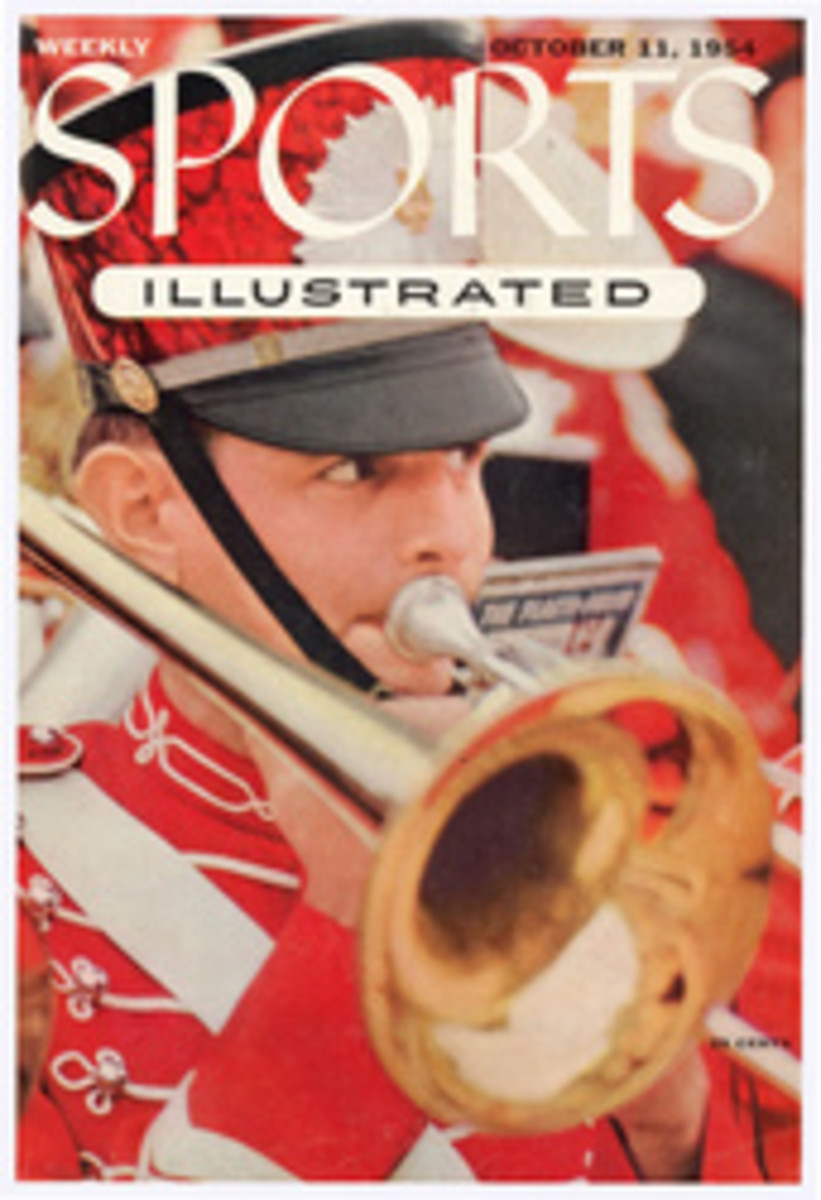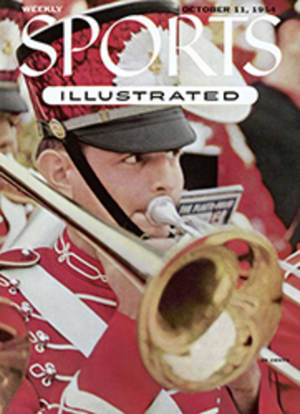
THE BANDS PLAY ON
This is the season of the college band, a phenomenon mothered by the need to cope with football stadium acoustics. No other music is loud enough. In days when mere hundreds huddled to watch football from flimsy wooden stands, or none at all, the students' well-meaning banjo and mandolin orchestras entertained spectators between halves. But the string ensembles, good enough for shedding tremolo tears about the college on the hill, have gone the way of the raccoon coat. They lacked both the volume required to entertain thousands and the brassy drive and thump a fight song needs.
PLAY YOUR WAY THROUGH COLLEGE
The fight song was born with football, before which it was unnecessary. Now, at some colleges, a sousaphone player has almost as good a chance to win a scholarship as the halfback he went to school with. A mandolin player has no chance at all. College bandsmen at some schools get course credit for ten hours or so a week spent in playing and drilling the complex, picturesque formations required of them today. Co-eds go to college on baton-twirling scholarships. What a baton-twirling co-ed needs most is pretty knees, which should also be chap-resistant.
The college band plays a limited repertoire. It will, for certain, do a sweetly pensive rendition of the Alma Mater and, for sure, a fight song. The Alma Mater lyric is likely to be founded on the poesy of a recently bygone day because that is when it was written. The odds are that there will be a reference to hill, valley, prairie or other topographical feature (example: Where the Blue Ridge Yawns its Greatness—Clemson Agricultural College) and to loyalty, mem'ries and font of wisdom. The fight song calls on the football team to fight, very often by means which would get a player ruled out of the game. There is, for example, Northwestern University's "Wild Cat" Song, which closes: "Scratch 'em, bite 'em, claw 'em, fight 'em. Yow! Yow! Yow! Yow! Yow! Yow! YOW!"
In addition, there are boasting songs and drinking songs and if the singers were to live up to them they would be expelled. The elements of boasting, drinking and fighting are at times blended into one full-throated song. A boasting-drinking song is likely to be a real rouser, like Georgia Tech's Ramblin' Wreck, who is a hell of an engineer and drinks his whisky clear. The tune, from an old English drinking song, Son of a Gamboleer, had previously been popular at Yale and some of the words are reminiscent of a ribald old ballad, Bell-Bottom Trousers. They say at Georgia Tech that the song was written about 1893 by a member of the football team en route to a game at Auburn, Alabama. No one seems to remember his name. He is presumably engineering somewhere.
FAR ABOVE WHATEVER WATERS
A great many other college songs are derivative in one way or another. There is a bitterness between Syracuse and Cornell because Cornell's Far Above Cayuga's Waters is more famous than Syracuse's Where the Vale of Onondaga, though both are built on the same tune. The tune is Annie Lisle, a schmaltzy ballad of Civil War days. Well, Annie Lisle is also the tune of Close Beside the Winding Cedars (Michigan State), Close Beside Cuyahoga's waters (University of Akron), On the Shores of South Carolina (The Citadel), Far Above the Walnut Valley (Southwestern), Living Symbol of Our. City (University of Toledo), Midst the Mountains of the Westland (Seattle Pacific), Where the Hills of Pennsylvania (Washington and Jefferson) and the aforementioned Where the Blue Ridge Yawns Its Greatness. Probably more besides.
Aside from the geographic features apparent in many Alma Mater lyrics, there is a recurrent totemism, due to the fact that so many colleges have picked panthers, lions, tigers and other formidable beasts as symbols of their prowess. Among the most impressive are Texas Christian's Horned Frogs, We Are All for You, Georgia Tech's tender My Yellow Jacket Girl, and Rice Institute's Owls! Awake and Sing.
What is solemnly sung today as the official song of the University of Texas, The Eyes of Texas, began as a rib on the university president, William L. Prather, who tried to stop a commotion brought on by the appearance in town of Carry Nation. The lady was bent on axing a beer parlor near the campus. Borrowing, as he often did, from Robert E. Lee's "The eyes of the South are upon you," the president said:
"Remember, young men, wherever you are and wherever you may be, the eyes of Texas are upon you. You are expected to uphold her tradition and not act as hoodlums and cheer this poor, deluded woman."
John Lang Sinclair, who had heard the phrase often enough as a student, picked it up for a 1903 University minstrel-show song which he wrote on the wrapping of a laundry bundle. It was a huge snicker to the students at the time, but as little as two years later, in 1905, the song had achieved its present dignity and was sung respectfully at the funeral of the president it parodied.
Among the oldest of football songs are the Rutgers Foot-Ball Song and Columbia's Foot-Ball Song, obviously written before anyone knew how to spell the game, let alone play it. They appear in a collection of college songs published in 1876, a time when the game was just emerging from soccer. The Rutgers song gives an idea of the style of the period and even a notion of what the game was like:
"The kickers are all in their rival rows
With scarlet caps and scarlet hose;
The word is given and off she goes
And up with the bully foot-ball."
(For the Founding Game with Princeton in 1869, the first intercollegiate game of foot-ball, which was then more like soccer, Rutgers players wore red turbans on their heads, and the school color became scarlet.)
Today's college bands, with shako-ed drum majorettes by the dozen and ornate uniforms, are very little like the simply clad marchers who first serenaded team and stands. Ivy League costuming comes closest to what it was in the old days of the twenties. The Harvard band, which is rated musically as the best in the East and only to be compared with Yale's, wears crimson coats and ties, white shirts, white trousers with crimson stripes, and no hats. At Yale the costume is dark-blue blazers, gray flannel trousers, white shoes, and again no hats. Princeton puts a touch of satire on Ivy League restraint by wearing straw boaters with orange-and-black bands as a topper to loud orange-and-black plaid jackets, black knit ties, gray flannel trousers and white buckskin shoes.
The Yale band has its memories, among them the time when Rudy Val-lee, leading it during a Yale-Georgia game, swung into Marching Through Georgia. It was a Harvard man, however, who flung the grapefruit at Rudy while he was singing Oh, Give Me Something to Remember You By.
No matter where in this world a college man goes he is likely to be caught up short sometime by hearing his old school song sung or played in the most improbable places. Notre Dame's Victory March has been used by Chinese street merchants in Tientsin to demonstrate the quality of their violins. Marines sang it going in for beachhead landings in the Pacific. Capt. Trevor E. Hughes of the British 51st Highland Division heard it in a concentration camp at Lodz, Poland. On Wisconsin, which John Philip Sousa called "the finest college melody ever written," was carried to the Mexican border by Wisconsin National Guardsmen in 1916 and to Europe in World War I. It was written by two Hamilton College men, whose first version started: "Minnesota, Minnesota...."
PHOTO
DRUM MAJORETTE, strutting her stuff at University of Tennessee, flaunts essential requirement of her job: pretty knees which can resist the cruel bite of autumn winds.
PHOTO
DEJECTED OKLAHOMA BANDSMEN HAD FINE VIEW OF JOHNNY LATTNER'S PASS INTERCEPTION IN 1953. NOTRE DAME WON, 28-21
PHOTO
WITH MARTIAL PRESENCE, BANDSMEN STEP OUT SMARTLY ON THE FIELD. HORNS BLARE, CYMBALS CRASH—IN VICTORY OR DEFFAT.
PHOTO
GLOCKENSPIEL ADDS TONE
PHOTO
ACROBATIC SANDY WIRTH HAS TWIRLING SCHOLARSHIP AT UNIVERSITY OF MIAMI

